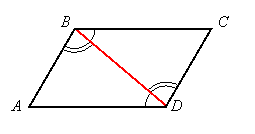Proof of the Triangle Midsegment Theorem
To shorten proofs in geometry, we can sometimes prove preliminary results. In the case of the Triangle Midsegment Theorem, a preliminary result is that opposite sides of a parallelogram are congruent. Recall that a parallelogram is a quadrilateral with opposite sides congruent. So first we will prove:
Theorem: The opposite sides of a parallelogram are congruent.
Proof:
|
Let the parallelogram be ABCD, and draw the diagonal |
 |
Now we can prove the Triangle Midsegment Theorem:
| Given: | M is the midpoint of |
 |
| Prove: | N is the midpoint of |
|
Proof:
We will show that the result follows by proving two triangles congruent. First locate point P on side ![]() so
so ![]() , and construct segment
, and construct segment ![]() :
:

Notice that ![]() is a transversal for parallel segments
is a transversal for parallel segments ![]() and
and ![]() , so the corresponding angles,
, so the corresponding angles, ![]() and
and ![]() are congruent:
are congruent:

Now, for ![]() and
and ![]() we have:
we have:
![]() (because M is the midpoint of
(because M is the midpoint of ![]() )
)
![]()
and ![]()
Therefore, these triangles are congruent by the SAS postulate, and so their other corresponding parts are congruent: ![]() ,
, ![]() , and
, and ![]() . Also, since
. Also, since ![]() (this was given),
(this was given), ![]() because these are corresponding angles for the transversal
because these are corresponding angles for the transversal ![]() . Therefore,
. Therefore, ![]() . But these are corresponding angles for segments
. But these are corresponding angles for segments ![]() and
and ![]() with transversal
with transversal ![]() , so by the Corresponding Angle Theorem,
, so by the Corresponding Angle Theorem, ![]() . Thus, MNCP is a parallelogram, and by Example 3 from the previous lesson, its opposite sides are equal:
. Thus, MNCP is a parallelogram, and by Example 3 from the previous lesson, its opposite sides are equal:![]() and
and ![]() :
:

Since BN and NC are both equal to MP, they are equal to each other, so N is the midpoint of ![]() . Likewise, since AP and PC are both equal to MN, P is the
midpoint of
. Likewise, since AP and PC are both equal to MN, P is the
midpoint of ![]() :
:
![]()
But AP = MN
Therefore ![]()